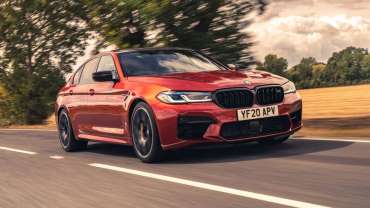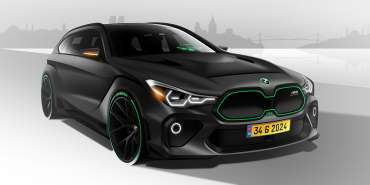Displaying items by tag: BMW M5
BMW M5 saloon review
The BMW M5 is the high-performance version of the standard BMW 5 Series and competes with the Mercedes-AMG E63, Porsche Panamera and Audi RS7 for buyers looking for a ‘super saloon’. The Mercedes matches the BMW most closely in shape and price, though – both are four-door saloons that will set you back nearly £100,000 before options.
A substantial amount of what you’ll pay for the car goes towards what’s under the bonnet. Now available in ‘Competition’ spec, the M5 is powered by a 616bhp 4.4-litre V8 petrol engine that takes the car from 0-62mph in only 3.3 seconds. Considering it weighs almost two tons, both the M5’s straight-line speed and agility are remarkable.
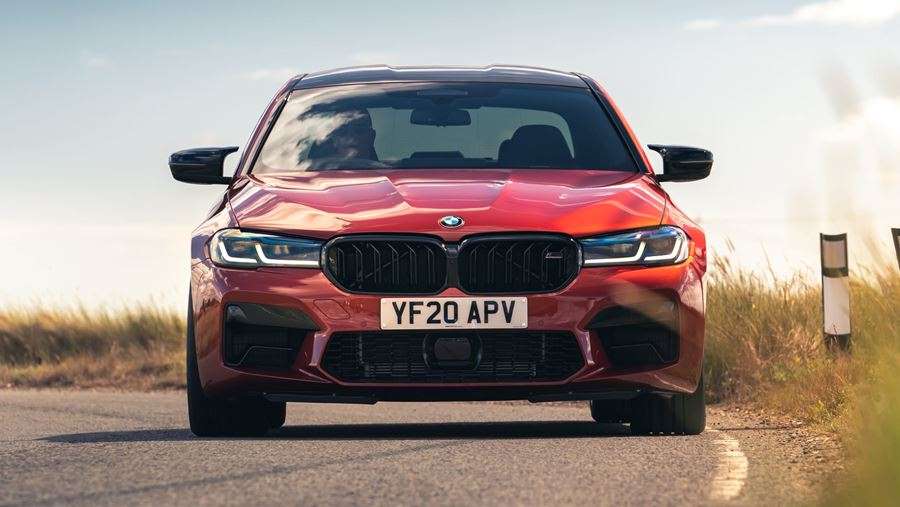
When the ‘F90’ M5 model was originally launched, it had 592bhp, with the 616bhp Competition model adding around £7,000 to the list price. As well as the extra power, it also had some styling tweaks, a sports exhaust and revised suspension.
In late 2020, the M5 Competition was facelifted along with the standard 5 Series. The changes included a tweaked front end, new LED lights and extra paint finishes. The interior was also updated with a new 12.3-inch infotainment system, and an array of new safety tech was added. Chassis changes were limited to a new adaptive suspension setup borrowed from the current M8 Gran Coupe.
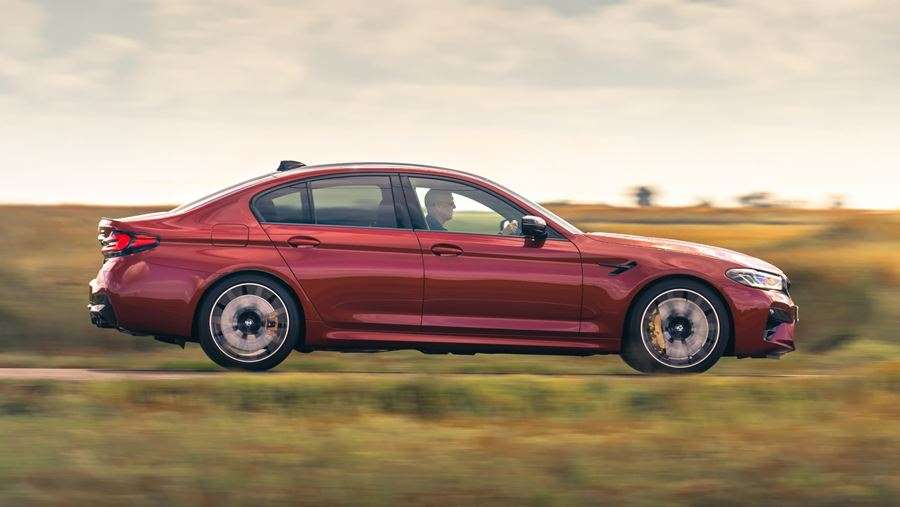
While the facelifted version of the M5 Competition will set you back over £100,000 before options, BMW also introduced an even faster model in 2021. Dubbed the M5 CS, it’s lighter than the standard car (weighing around 1,800kg) and is billed as a track-focused saloon. It’s quicker too, managing 0-62mph in three seconds thanks to an increased power output of 626bhp. Naturally, it costs more than the standard car, with a starting price of around £140,000.
The M5 Competition is equipped with BMW’s M xDrive four-wheel-drive system, which means there’s more grip and cornering performance than ever. Purists will be heartened to hear that firstly, the system has been engineered to give the car a rear-wheel-drive feel and, secondly, there’s a mode to send all power to the rear if you want.
While it’s incredibly quick, the M5 Competition is also capable of satisfactorily carrying out the duties of a luxury saloon car. In Comfort mode, the ride is soft enough to soak up all but the worst bumps in the road and the interior is plush and luxurious.
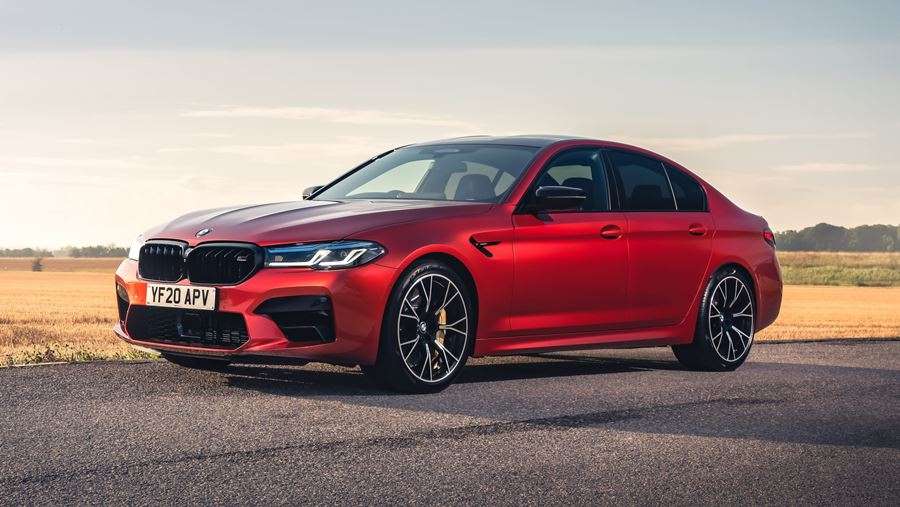
However, despite its brilliance as a high-speed cruiser and its competence on twisty roads, the latest M5 doesn't quite engage you the way its predecessors did – it feel like there's a hi-tech barrier between you and the car; the steering feels well weighted but it's surprisingly muted in terms of feel, for example.
But this criticism is also true of many of the M5's super saloon competitors and is something of a sign of the times. It doesn't prevent the BMW from being at least equal to its Mercedes rival - even if the Merc has the more exciting engine - and in Competition form, the M5 is the best all-round supersaloon you can buy. Its handling flaws can also be remedied if you're prepared to pay the extra for the M5 CS, because its revised suspension is a revelation. Not only does it feel more settled, it's better to drive and more involving too.
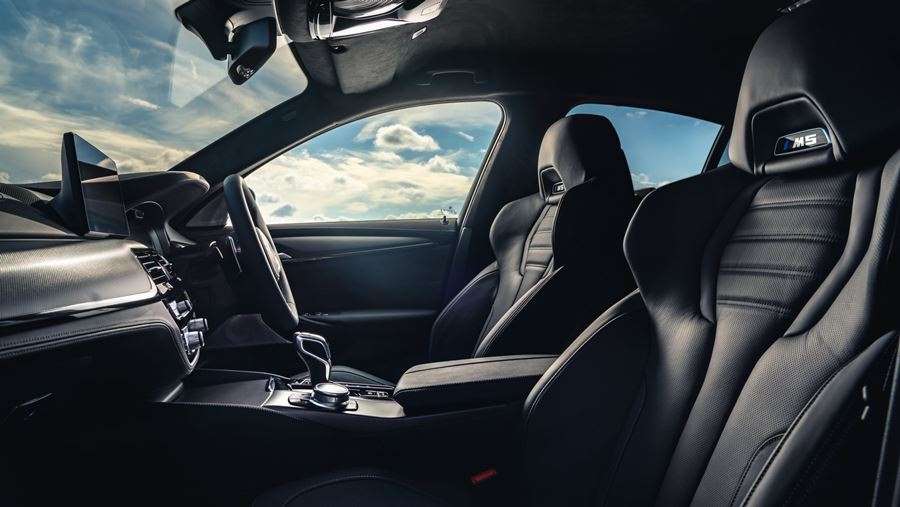
MPG, running costs & CO2
The BMW M5 isn't cheap to buy and it won't be cheap to run either
The M5 Competition is only available with one large engine and it’s been designed for power rather than fuel economy. The introduction of turbocharging and the downsizing of the engine compared with previous M5s is a nod to improving efficiency, but the 4.4-litre V8 still only returns around 25mpg, which we were able to get close to during our test. However, as with any super saloon, driving the M5 with any kind of enthusiasm or in heavy traffic will lead to fuel economy figures dropping into the mid-teens or lower.
After the first year's CO2-based road tax (generally included in the on-the-road price), every M5 will cost the standard rate each year to tax. With a list price of more than £40,000, the M5 is also liable for an additional VED surcharge in years two to six of ownership, making the bill higher during that period. CO2 emissions starting from 254g/km place the M5 in the highest Benefit-in-Kind band for company-car drivers and it's also expensive to insure, sitting in the top group 50.
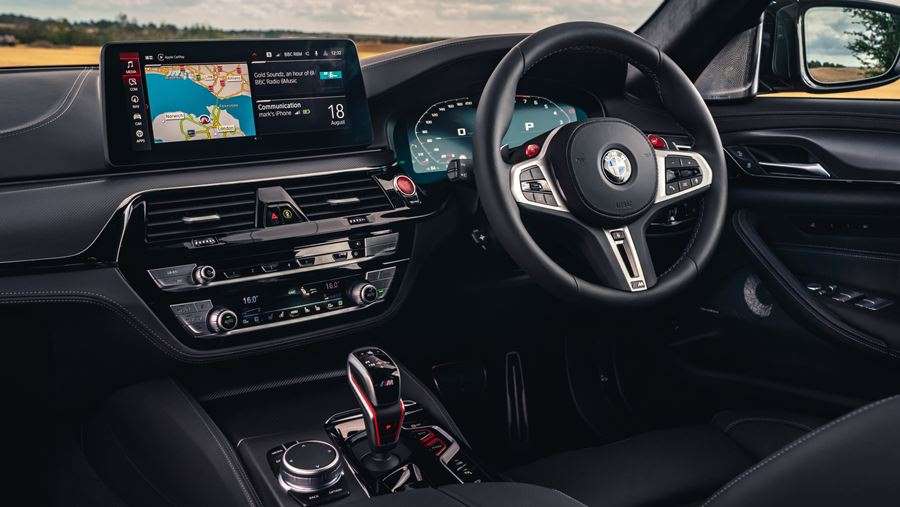
Engines, drive & performance
The BMW M5 is incredibly quick and a great driver's car
The M5 Competition uses a twin-turbo 4.4-litre V8 engine that produces 616bhp and gets the car from 0-62mph in 3.3 seconds. On paper, it has the edge on performance over the Mercedes-AMG E63 and only just falls behind the E63 S, but its engine goes about its business in a rather different way to its rival. Where the Mercedes barks and rumbles, the BMW screams and howls; it'll come down to personal taste which sound you'll prefer. The heart of the matter is that the M5 feels more like a racing car than the E63, but that's not necessarily what you want from a supersaloon.
The standard M5, originally launched in 2018, produced 592bhp and was capable of 0-62mph in 3.4 seconds, only slightly behind the 3.3 seconds of the Competition version.
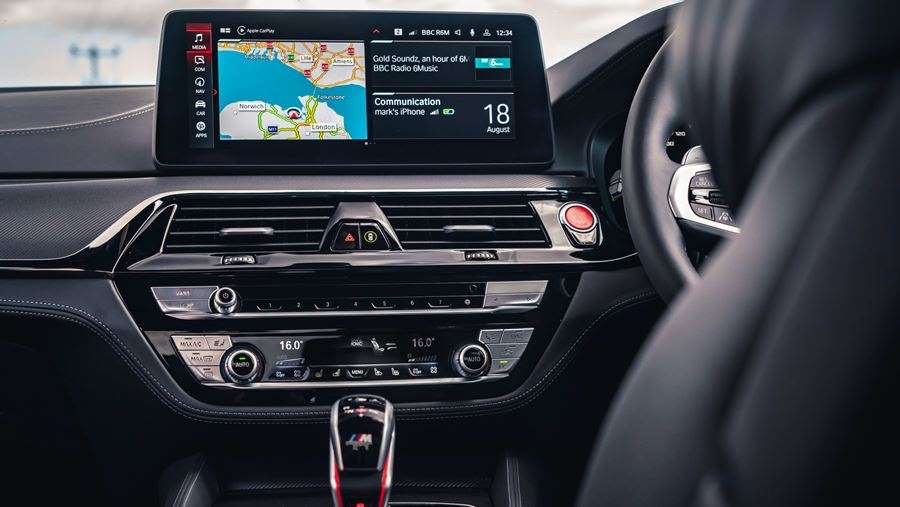
While the M5 Competition isn’t noticeably faster in a straight line than the standard M5, it gets an array of minor suspension tweaks that really improve its overall performance. The changes mean the Competition is more responsive, with more precision and sharpness than the standard M5. Body control is even more impressive too.
The use of BMW’s xDrive four-wheel-drive system for the first time in the M5's history means there’s no shortage of traction when you put your foot down, with immense levels of grip during standing starts and when accelerating through corners. Despite sending power to all four wheels, the M5 feels like a very balanced rear-wheel-drive car, with the majority of the engine’s power going to the rear wheels during normal driving.
The M5 also has a clever Active M differential that apportions power between both sides of the car to aid cornering performance, while the xDrive system can send power to the front wheels to help pull you out of fast corners.
The car’s setup and driving modes can be controlled via the red coloured steering-wheel mounted ‘M1 and ‘M2’ buttons allowing you to link each to a preset mode. For those who prefer to use the M5s standard settings, the buttons can quickly cycle through Road, Sport or Track mode as well.
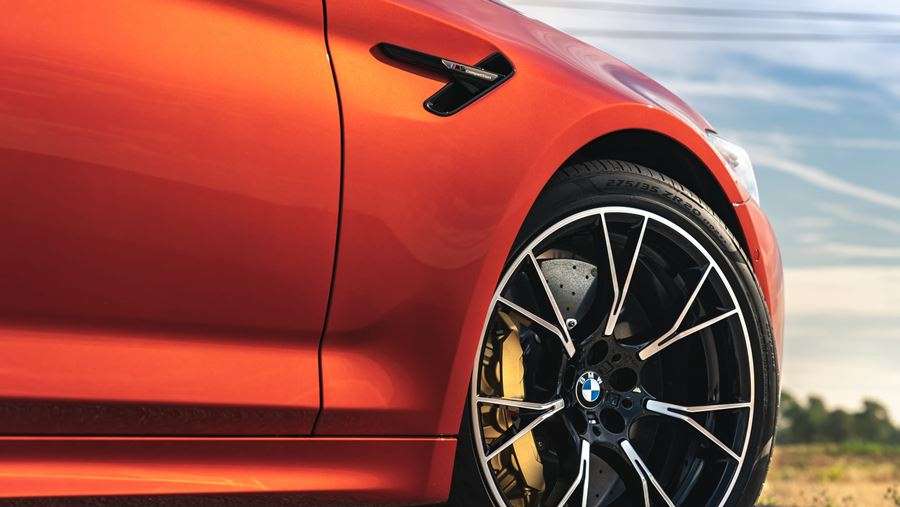
It's a very responsive system and unobtrusive in operation, suiting the M5's eye-watering speed – we managed 0-62mph in just 3.2 seconds in testing. The eight-speed automatic gearbox performs obediently, too, changing gears smoothly and quickly when you demand it through the column-mounted shift paddles.
Carbon-ceramic brakes are an expensive extra at around £7,670 but they provide huge stopping power on a consistent basis and seem particularly suited to a car of the M5’s power and weight. This option also adds a gold paint finish to the brake calipers.
The optional M Pro package focuses on performance raising the car’s top speed to 190mph from an electronically limited 155mph. It also adds the carbon-ceramic brakes, and costs an extra £7,995. The package also includes a one-day BMW M driver training course at a track in either the UK or in Germany.
For all its power and prowess, the M5 Competition lacks the absolute ultimate in excitement, mainly because of its slightly inert steering. Although accurate enough in use, it seems to filter out some of your inputs, so you never feel quite as connected to the car as you'd like.
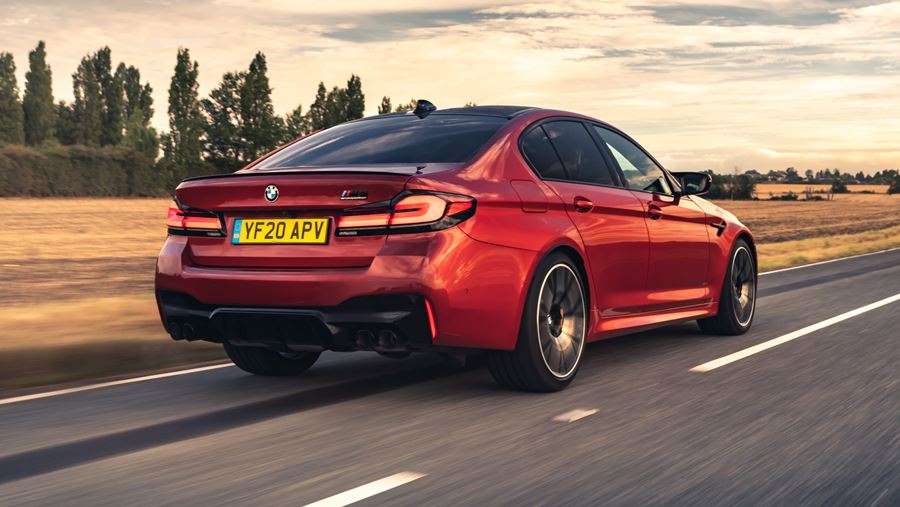
While the Mercedes-AMG E63 does provide a more visceral driving experience, with its snarling exhaust note and more overtly muscular character, there’s no doubt that in Competition spec, the M5 is closer to matching its German rival for sheer exhilaration and driving thrills.
Released in 2021, the BMW M5 CS (Club Sport) successfully fixes most of the Competition's faults, if you're prepared to spend around £140,000 on a saloon car. Fitted with the adaptive dampers from the M8 Gran Coupe, it sits just 7mm lower, but the car feels more stable and less upset by even roads. This improves driver confidence and makes the driving experience feel more fluid.
Power increases to 626bhp and the CS weighs around 70kg less than the regular car, cutting the 0-62mph time to three seconds. It's the most powerful production BMW car ever built but it's the handling upgrades that make the biggest difference. Carbon-ceramic brakes are fitted as standard to boost stopping power.
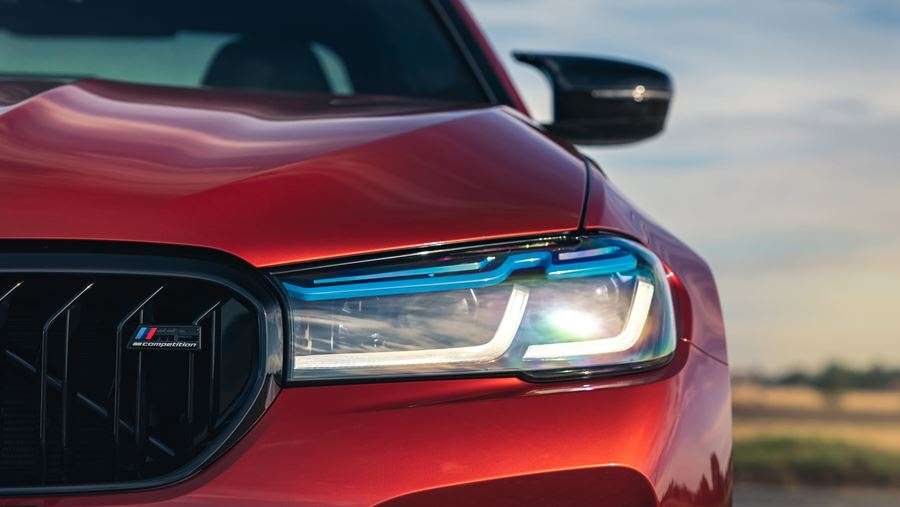
Interior & comfort
Luxurious comfortable interior with plenty of standard equipment
The M5 comes with heated leather sports seats for the driver and front passenger, which give huge amounts of support and comfort. The dashboard is logically laid-out and the controls for the car’s on-board tech and systems are easy to use. The M5 comes with a leather interior as standard, giving it the upmarket feel inside you’d expect from an expensive BMW. Choose the M5 CS and the exterior is set apart by a new bodykit, with a large diffuser between the quad exhaust pipes.
Also present is BMW’s iDrive infotainment system, which runs on a crystal-clear 12.3-inch infotainment touchscreen. It's quick and responsive to use, with clear graphics. Every M5 gets an array of technology as standard, including sat nav, wireless Apple CarPlay and Android Auto, and wireless charging for your smartphone. A new 12.3-inch digital dial cluster also features, alongside a head-up display with unique M Division graphics.
The rotary controller has a touch-sensitive top, which allows you to sketch the shape of a letter on the pad with your finger (to enter a postcode for the sat nav, for example), rather than use the wheel to scroll through the alphabet. The system is packed with features and very easy to use.
The M5 is undoubtedly a performance car, but it’s also a luxury saloon and the ride manages to be impressively smooth when the car’s adaptive dampers are in Comfort mode. Even with large 20-inch alloy wheels, which can so often transmit every little imperfection from the road inside, the M5 is still sufficiently compliant to make the car a comfortable motorway cruiser.
This is one way in which the M5 trumps the Mercedes-AMG E63, as the latter feels much firmer and less comfortable by comparison. The Sport setting for the M5's dampers improves body control at the cost of some of the smoothness in Comfort, while the Track mode is best saved for a circuit, as the ride becomes so firm that any passengers will get shaken around. Some may feel the bucket seats fitted in the M5 CS are a step too far for an everyday car. They’re the same carbon items available in the latest M3 and M4, offering excellent support but feeling quite hardcore for a luxury saloon.
Practicality & boot space
The BMW M5 is as practical as the standard 5 Series
The M5’s chunky front sports seats don’t have a noticeable impact on rear space, so passengers in the back still have good head and legroom. Storage spaces are generously sized, with plenty of room in the door bins, glovebox and central cubbyhole. There are cup-holders and a place to charge the car’s Display Key or your mobile phone wirelessly.
Despite having a four-wheel-drive system, which can often impinge on boot space, the M5 still offers 530 litres of luggage room, just like the standard 5 Series. This is fractionally smaller than the 540 litres offered by the Mercedes-AMG E63, but certainly not enough of a difference to be a deciding factor in which of the two cars you choose to buy.
Reliability & safety
Expect the BMW M5 to match the high standards set by the basic 5 Series
BMW finished in 27th place out of 30 manufacturers in our 2020 Driver Power poll, lagging behind German rivals Audi who placed 21st. it's a worrying trend, particularly as it was partly down to 20.8% of owners reporting at least one fault within the first 12 months of ownership.
The M5 won’t be crash-tested as a standalone model, but when the standard 5 Series was put through its paces by Euro NCAP, it was awarded a five-star rating, with an adult occupancy safety score of 91%. It achieved an 85% score in the child occupant category and the car’s autonomous emergency braking system was highly commended.
The latest M5 Competition carries over all of the safety technology from the facelifted 5 Series, including updated lane keeping, lane changing assist and a 360-degree camera. Buyers can also add the Driving Assistant Professional, which uses the Active Navigation to automatically perform lane changes in advance. Rear cross-traffic alert and adaptive cruise control also feature.
BMW’s Parking Assistant Plus system was added to the M5 in the mid-2020 facelift, and is capable of automatically reversing the car into a space for a distance of up to 50 metres. A further addition is Drive Recorder, which uses a series of cameras dotted around the bodywork to continuously record footage as you drive, automatically saving the 20 seconds before and after any collision.
(carbuyer.co.uk)
New 2024 BMW M5: full-electric hyper saloon to have 1000bhp
New 2024 BMW M5: full-electric hyper saloon to have 1000bhpNew 2024 BMW M5: full-electric hyper saloon to have 1000bhpNew 2024 BMW M5: full-electric hyper saloon to have 1000bhpNew 2024 BMW M5: full-electric hyper saloon to have 1000bhpNew 2024 BMW M5: full-electric hyper saloon to have 1000bhpNew 2024 BMW M5: full-electric hyper saloon to have 1000bhp
More info on BMW 5-Series
► 2024's G60-gen M5 to go electric
► 1000bhp e-saloon alongside PHEV
► Tech from iNext and i4 underneath
BMW is already amping up for the next-generation M5 super saloon. Arriving in 2024, this new version will be a dramatic change from the current F90.
Why? Because it’s expected to be the first M car to be exclusively electrified – either as a ‘Power PHEV’ or full-electric car.
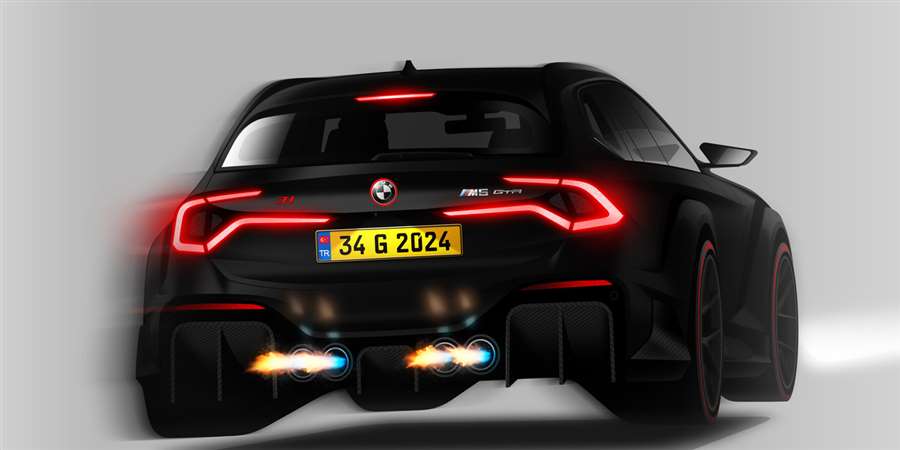
Labelled G60, the next 5-series bows in the third quarter of 2023. One year later, the seventh-generation M5 will start chasing fast Audis and Mercs with these two variants. The plug-in hybrid will use the same powertrain as the upcoming X8 M, with a V8 petrol engine and e-motors totalling around 750bhp and 737lb ft of torque sent to all four wheels.
2024's all-electric M5
The zero-emission M5, meanwhile, is a member of the CLAR WE family. Power will be provided by Gen V pouch-type batteries. Although BMW knows that it would have been wiser to switch to larger Tesla-style round cells for safety, stability and performance reasons, it is now too late for such a radical change. The most potent conventional energy cell in question is rated at 135kWh; it can be hooked up to a 400V charger good for up to 350kW. In a second step, BMW will upgrade to the 800V standard pioneered by Porsche with its Taycan.
BMW is openly working on a ‘power BEV’, using a 5-series mule. That model has three e-motors borrowed from the powertrain we’ll see in the electric i4 and the iNext SUV. One drives the front axle while the rear wheels get a motor each. Numbers? 711bhp and sub-3.0sec 0-62mph.
The maximum projected WLTP range is 435miles, the targeted 0-62mph acceleration time is 2.9sec. In terms of power output, internal documents suggest two 250kW motors driving the rear wheels and one 250kW unit propelling the fronts. That's 750kW or around 1000bhp in total – that may sound awesome, but it will in less than twelve months be eclipsed by Tesla's tri-motor Plaid configuration.
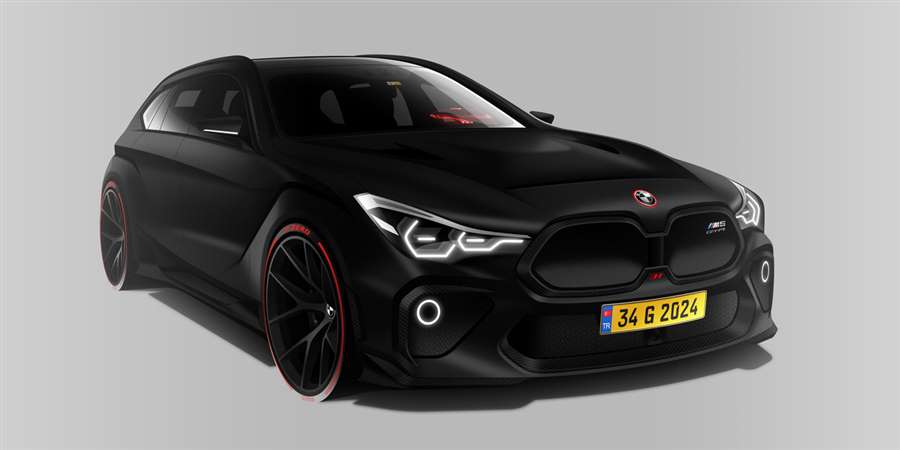
Electric car battery tech explained
Comments a member of the M Division R&D team: “The Bavarian Motor Works are latecomers to the EV scene, and the same applies unfortunately to autonomous driving. Mid-term, our only stable competitive advantage is ride, handling and roadholding. But the biggest challenge by far is cost, which is why the board has buried the projected halo car.”
BMW Group's electric roadmap
The halo car, which was expected to be based on the Vision M Next concept, has been canned.
Given the electric M5's use of the CLAR WE architecture, there will be commonality with other zero-emission models from BMW Group. BMW has already been spotted testing the CLAR WE platform via some 7-series mules (above).
This extends to the 7-series eDrive out in 2023 and, eventually, the current Phantom which goes electric in very small numbers starting in 2022. A silent Cullinan is due to follow in 2027.
Source: carmagazine.com

